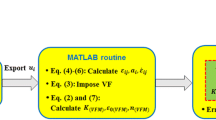Abstract
The aim of the present study is to propose a procedure for identifying dynamic strain hardening parameters using the virtual fields method (VFM) so as to provide more accurate hardening properties at high strain rates for automotive crash analysis simulations. In order to validate the procedure, a proper elasto-plastic constitutive model was adopted and simulated measurements were obtained using a finite element (FE) analysis program. The same identification procedure as that which will be implemented in the experiments was applied. The VFM was used as an inverse analytical tool to retrieve the constitutive parameters. Since precise measurement of the applied load is not an easy task at high strain rates due to the inertial effect, the identification was carried out using the acceleration fields without utilizing load information. A sensitivity study was conducted to assess the effect of several experimental conditions on the identification. Then, the identified parameters using the VFM were compared with the target ones, which were fed into the FE simulations. Very promising results were obtained using the VFM.
Similar content being viewed by others
References
Choi, K. Y., Lee, M. G. and Kim, H. Y. (2013). Sheet metal forming simulation considering die deformation. Int. J. Automotive Technology 14, 6, 935–940.
Dunne, F. and Nik, P. (2005). Introduction to Computational Plasticity. Oxford University Press. New York.
Grédiac, M. and Pierron, F. (2006). Applying the virtual fields method to the identification of elasto-plastic constitutive parameters. Int. J. Plasticity 22, 4, 602–627.
Johnson, G. R. and Cook, W. H. (1985). Fracture characteristics of three metals subjected to various strains, strain rates, temperatures and pressures. Eng. Fract. Mech. 21, 1, 31–48.
Kim, J. H., Serpantié, A., Barlat, F., Pierron, F. and Lee, M. G. (2013). Characterization of the post-necking strain hardening behavior using the virtual fields method. Int. J. Solids. Struct. 50, 24, 3829–3842.
Park, J. K., Kim, Y. S., Seo, O. S., Lee, M. G. and Kim, H. Y. (2013). Improved hot-stamping analysis of tubular boron steel with direct measurment of heat convection coefficient. Int. J. Automotive Technology 14, 5, 917–922.
Pierron, F. and Grédiac, M. (2012). The Virtual Fields Method. Springer. New York.
Pierron, F., Sutton, M. A. and Tiwari, V. (2011). Ultra high speed DIC and virtual fields method analysis of a three point bending impact test on an aluminium bar. Exp. Mech. 51, 4, 537–563.
Sutton, M. A., Orteu, J. J. and Schreier, H. (2009). Image Correlation for Shape, Motion and Deformation Measurements: Basic Concepts, Theory and Applications. Springer. New York.
Author information
Authors and Affiliations
Corresponding author
Rights and permissions
About this article
Cite this article
Kim, J.H., Lee, G.A. & Lee, M.G. Determination of dynamic strain hardening parameters using the virtual fields method. Int.J Automot. Technol. 16, 145–151 (2015). https://doi.org/10.1007/s12239-015-0016-3
Received:
Revised:
Accepted:
Published:
Issue Date:
DOI: https://doi.org/10.1007/s12239-015-0016-3




